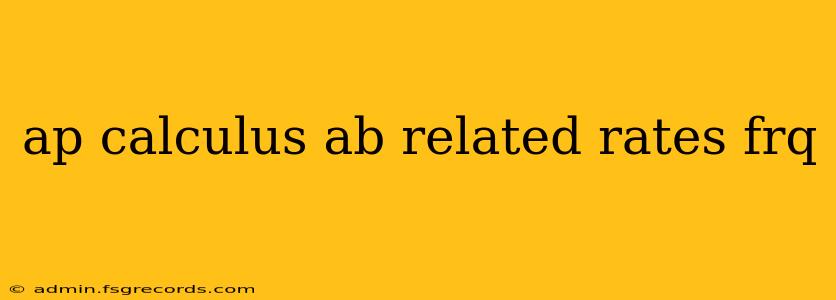The AP Calculus AB exam's free-response questions (FRQs) on related rates are notoriously challenging. These problems require a deep understanding of derivatives, implicit differentiation, and the ability to translate word problems into mathematical equations. This guide will break down the key concepts, provide strategies for tackling these problems, and offer examples to solidify your understanding.
Understanding Related Rates Problems
Related rates problems involve finding the rate of change of one quantity in terms of the rate of change of another quantity. The key is recognizing that these quantities are related, usually through a geometric formula (like area, volume, or Pythagorean theorem), and that their rates of change are connected through implicit differentiation.
Key Elements:
-
Identify the Variables: Carefully read the problem and identify all variables involved. Clearly define what each variable represents (e.g., x = radius, y = height, A = area).
-
Establish Relationships: Determine the relationship between the variables using geometric formulas or other given information. This is often the most crucial step.
-
Implicit Differentiation: Differentiate the equation from step 2 with respect to time (t). Remember to use the chain rule:
d/dt(f(x)) = f'(x) * dx/dt. -
Substitute and Solve: Substitute the known values (including rates of change) into the differentiated equation and solve for the unknown rate of change.
-
Units: Always include the correct units in your final answer.
Common Geometric Formulas Used in Related Rates Problems
Familiarity with these formulas is essential for success:
- Area of a circle: A = πr²
- Volume of a sphere: V = (4/3)πr³
- Volume of a cone: V = (1/3)πr²h
- Volume of a cylinder: V = πr²h
- Pythagorean theorem: a² + b² = c²
- Area of a triangle: A = (1/2)bh
Strategies for Solving Related Rates FRQs
1. Draw a Diagram: A visual representation is incredibly helpful in understanding the relationships between variables.
2. List Knowns and Unknowns: Organize the information given in the problem. What rates of change are given? What rate of change are you asked to find?
3. Write an Equation: This is the most important step. Find the equation that relates the variables.
4. Differentiate Implicitly: Use implicit differentiation with respect to time (t).
5. Substitute and Solve: Plug in the known values and solve for the unknown rate of change.
6. Check your Answer: Does your answer make sense in the context of the problem? Are the units correct?
Example Problem
A spherical balloon is being inflated at a rate of 10 cubic centimeters per second. How fast is the radius increasing when the radius is 5 cm?
Solution:
-
Variables: V = volume, r = radius, t = time. We are given dV/dt = 10 cm³/s and we want to find dr/dt when r = 5 cm.
-
Relationship: V = (4/3)πr³
-
Differentiate: dV/dt = 4πr²(dr/dt)
-
Substitute and Solve: 10 = 4π(5)²(dr/dt) => dr/dt = 1/(10π) cm/s
Therefore, the radius is increasing at a rate of 1/(10π) cm/s when the radius is 5 cm.
Mastering Related Rates: Practice Makes Perfect
The key to success with related rates FRQs is consistent practice. Work through numerous problems, focusing on carefully interpreting the word problems and setting up the correct equations. The more you practice, the more comfortable you'll become with the process, and the better equipped you'll be to tackle even the most challenging problems on the AP Calculus AB exam. Remember to utilize past AP exam FRQs for realistic practice and to identify areas needing further attention. Good luck!

